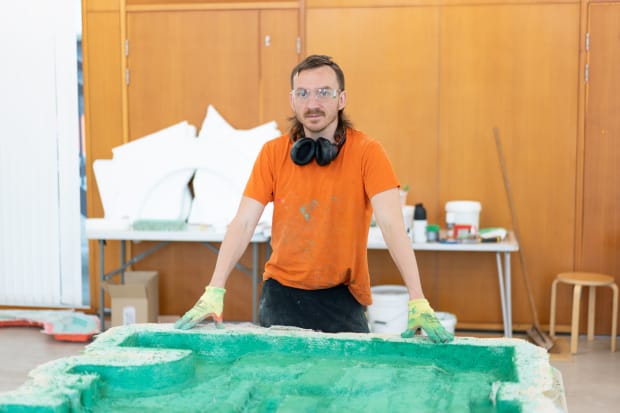-
-

-
The gallery at QUEERCIRCLE, itself with bare concrete columns, exposed electrical and extraction conduits hanging overhead, here becomes the context of Clocking Off, Zajko’s reimagined and abstracted factory floor—one which, as with much of Zajko’s work, uses personal memories of his childhood and family history in post-communist Poland as the foundations to create a shifting—and at times conflicting—picture of the contemporary relationship between modernity, time, technology and the human. Framed by a soft horizon line of cool seafoam green, a light mosslike pigment typically used in factories not only to repel dirt but for its calming and stress-releasing properties, the exhibition marries the hard grammar of industrial labour with Zajko’s voluptuous ceramic line-language to create an enveloping mixture of desire, dislocation, anxiety and nostalgia.
This uneasiness is felt immediately in the performative aspects of the exhibition. Small urn-like figures, Bobbin I - III, replete with frozen synthetic sweat-crowns and spool-esque chests, quietly leak through internal conduits, secreting chemicals typically used to test fabric quality in the textile industry through small holes in their steel bases. A larger quasi-religious sculpture, Herm, featuring a prosthetic aged knee cap slowly discolours and stains, oozing the same material over a minimalist steel plinth and gutter that slowly oxidises over time. And finally, the affronting Sisyphus, a colossal kinetic pendulum sculpture rhythmically driving back and forth through the gallery; the feeling inferred is one of perpetual arrested exhaustion, alienating the human body from dozens of complex biological ‘clocks’ or coexisting rhythms that exist within each of us—cardiac, digestive, nervous, molecular—in service of a singular and monolithic, monotonised machine time.
-

-
Indeed, it is clear that a number of anxieties are embedded in the framework of Clocking Off: feelings of homesickness and nostalgia, fears of post-industrial decline, the denigration of worker’s rights, industry, conflict and war. And yet despite this, I can see that the exhibition speaks equally to a culture of gratification and desire: that one might enjoy, however perversely, the hysterical, masochistic exhaustion of the mines, the foundries and factories. That emulating the impervious rhythms, efficiency and dynamism of mechanisation, the choreography of the machine and extension of one’s body to an assemblage of organic, chemical and machinic processes, is something to embrace if not celebrate. Throughout there is a sense of arrested satisfaction—but the yearning for it nonetheless remains in all its messy, complicated and vexed desire.
For me, these works do for textile production what Richard Hamilton once did for the automobile, they sublimate, exploit, delight in and affirm technological process as a vehicle for desire— connected to, through and with the body. Clocking Off exposes a series of libidinal displacements and investments that register how, in a single moment, it is both we who have engineered machines and machines that have engineered us. And that in spite of omnipresent proclamations of the compatibility, even harmonization, between human time and the temporalities of industrial systems, the lived realities of this relationship are filled with disjunctions, fractures, and continual disequilibrium.
-
— Charlie Mills
-

-
 Photo credit: Lucy Rose Shaftain-Fenner, 2023
Photo credit: Lucy Rose Shaftain-Fenner, 2023




